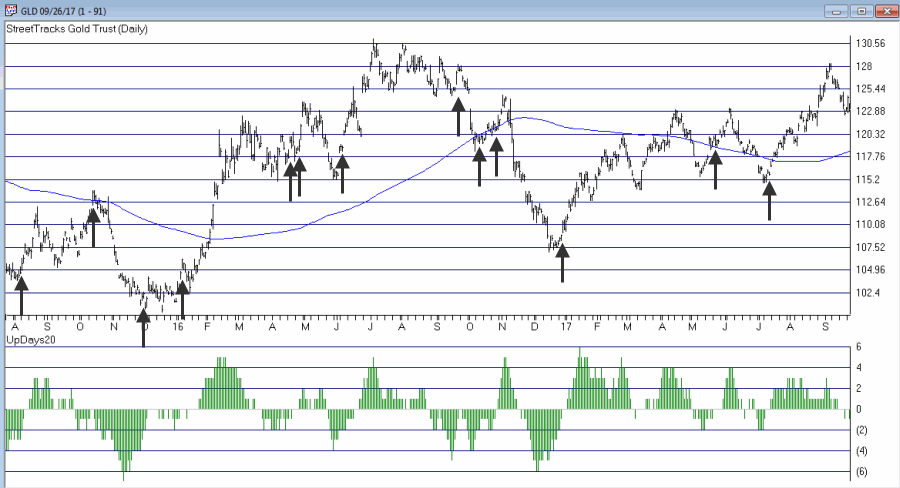The Bad News
There are no “magic bullets” when it comes to trading. There are people in this industry who have literally tested scores of indicators. Every trend-following indicator looks like a gold mine when it latches onto a huge trend and rides it (but not so much when it starts getting whipsawed). And every overbought/oversold indicator looks like a gift from heaven when it somehow manages to peak (or valley) and then reverses right at a high (or low). And then the next time the thing gets oversold, the security in question just keeps plunging and the previously “amazingly accurate” indicator gets more and more oversold.
What I am about to discuss is likely no better or worse than a lot of other indicators. Still, I like it.
UpDays20
I call this indicator 'UpDays20' and learned it originally from Tom McClellan of McLellan Financial Publications. My calculation may be slightly different because I wanted an indicator that can go both positive and negative. For a given security, look at its trading gains and losses over the latest 20 trading days.
UPDays20: Total # of Up days over the last 20 trading days minus 10 days.
So if 10 of the last 20 trading days showed a gain, then UpDays20 would read exactly 0.
If only 6 of the last 20 trading days showed a gain then UpDays20 would read -4
As a “trading method” it is always advised that this indicator – like most other indicators – NOT be used as a standalone approach to trading. That said, the way I follow this indicator is as follows.
- Step 1) UpDays20 drops to at least -2
- Step 2) UpDays20 rises 2 points from a low
- Step 3) The security in question then rises above its high for the previous 2 trading days
It is preferable to follow this setup when the security in question is above its 200-day moving average, but that is up to the trader to decide (the danger to using this with a security below its 200-day moving average is that it might just be in the middle of a freefall. The upside is that counter-trend rallies can be fast and furious – even if sometimes short-lived).
Again, there is nothing magic about these particular steps. They are simply designed to do the following:
- Identify an oversold condition
- Wait for some of the selling pressure to abate
- Wait for the security to show some sign of reversing to the upside
Like just about every other indicator/method, sometimes it is uncannily accurate and sometimes it is embarrassingly wrong (hence the reason experienced traders understand that capital allocation and risk management are far more important than the actual method you use to enter trades).
In this previous article I wrote about using this indicator with TLT. Figure 1 and 2 display the “buy” signals generated using the rules above for IYT and GLD.

Figure 1: Courtesy AIQ TradingExpert

Figure 2: Courtesy AIQ TradingExpert
Are these signals good or bad? That is in the eye of the beholder and not for me to say. One big unanswered question is “when do you exit?” That's beyond the scope of article, here's a rule of thumb: selling some at the first good profit, then use a trailing stop.
Some of the signals displayed in Figures 1 and 2 are great, others not so much. Interestingly, some of the signals in Figures 1 and 2 that don’t look too timely at first blush actually offered a profitable opportunity to a trader who was inclined to take a quick profit. Again, how you allocate capital and when you exit with a profit and when you exit with a loss would likely have as much impact on results as the raw “buy” signals themselves.
Summary
Don't start trading tomorrow based on UpDays20. No claim is being made that the steps detailed herein will result in profits nor even that this is a good way to trade.
